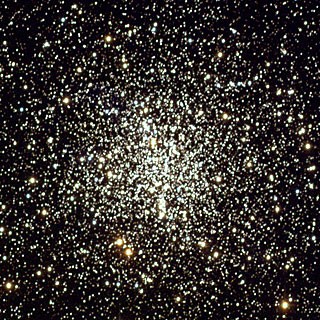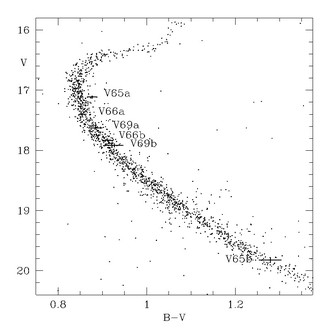
In paper "The cluster ages experiment (CASE). V. Analysis of three eclipsing binaries in the globular cluster M4" by J. Kałużny, M. Różyczka, W. Krzemiński, W. Pych from NCAC and their collaborators authors use photometric and spectroscopic observations of the eclipsing binaries V65, V66, and V69 in the field of the globular cluster M4 to derive masses, radii, and luminosities of their components. The orbital periods of these systems are 2.29, 8.11, and 48.19 days, respectively.
The measured masses of the primary and secondary components (Mp and Ms ) are 0.8035 ± 0.0086 and 0.6050 ± 0.0044 M sun for V65, 0.7842 ± 0.0045 and 0.7443 ± 0.0042 M sun for V66, and 0.7665 ± 0.0053 and 0.7278 ± 0/0048 M sun for V69. The measured radii (Rp and Rs ) are 1.147 ± 0.010 and 0.6110 ± 0.0092 R sun for V66, 0.9347 ± 0.0048 and 0.8298 ± 0.0053 R sun for V66, and 0.8655 ± 0.0097 and 0.8074 ± 0.0080 R sun for V69. The orbits of V65 and V66 are circular, whereas that of V69 has an eccentricity of 0.38. Based on systemic velocities and relative proper motions, we show that all three systems are members of the cluster. We find that the distance to M4 is 1.82 ± 0.04 kpc—in good agreement with recent estimates based on entirely different methods. We compare the absolute parameters of V66 and V69 with two sets of theoretical isochrones in mass-radius and mass-luminosity diagrams, and for assumed [Fe/H] = –1.20, [α/Fe] = 0.4, and Y = 0.25 we find the most probable age of M4 to be between 11.

Diagram color-magnitude for M4 with indication of investigated components.
Photo at the top: Globular Cluster M4 - NOAO Ground-Based Image (credit: NOAO/AURA/NSF).






